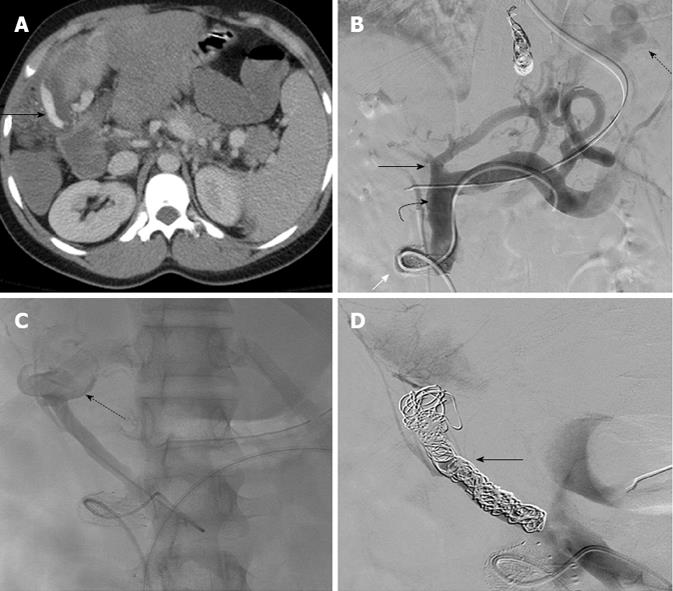Copyright
©2013 Baishideng Publishing Group Co.
World J Radiol. Oct 28, 2013; 5(10): 381-385
Published online Oct 28, 2013. doi: 10.4329/wjr.v5.i10.381
Published online Oct 28, 2013. doi: 10.4329/wjr.v5.i10.381
Figure 1 Case 1: Intra-hepatic portal venous injury.
A: Wedged carbon dioxide venogram of the right hepatic vein shows main portal vein (arrow) and brisk active extravasation from the right branch of the portal vein (curved arrow) into the peritoneum (white arrow); B: Portal venogram from the marked pigtail using iodinated contrast confirms the active extravasation into the peritoneum (white arrow); C: Portal venogram obtained after successful deployment of 10 mm x 8 cm length Viatorr stent (white arrow) shows the patent shunt with a minimal residual extravasation (arrow) from the previously noted site of bleeding.
Figure 2 Case 2: Traumatic hemorrhage from a jejunal varix.
A: Contrast enhanced computed tomography axial image shows contrast extravasation tracking along the outer wall of the hepatico-jejunostomy loop (arrow); B: Venogram performed by a trans meso-caval shunt (white arrow) approach shows large gastric fundal varices (dotted arrow), dilated superior mesenteric vein (curved arrow). The main portal vein is obliterated (black arrow); C: Selective venogram of the hepaticojejunostomy loop branch of the superior mesenteric vein shows dilatation of this branch with active extravasation of the contrast from the hepaticojejunostomy loop (dotted arrow); D: Multiple coils were used to occlude the branch (arrow).
- Citation: Sundarakumar DK, Smith CM, Lopera JE, Kogut M, Suri R. Endovascular interventions for traumatic portal venous hemorrhage complicated by portal hypertension. World J Radiol 2013; 5(10): 381-385
- URL: https://www.wjgnet.com/1949-8470/full/v5/i10/381.htm
- DOI: https://dx.doi.org/10.4329/wjr.v5.i10.381










